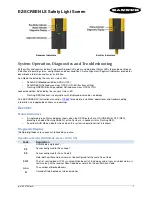
R5906897 /02
Prometheus III
108
8.6 ICMP SDI specifications
3G-SDI
Serial Digital Interface (SDI) is a serial link standardized by ITU-R BT.656 and the Society of Motion
Picture and Television Engineers (SMPTE). SDI transmits uncompressed digital video over 75-ohm
coaxial cable within studios, and is seen on most professional video infrastructure equipment. The
first revision of the standard, SMPTE 259M, was defined to carry digital representation of analog
video such as NTSC and PAL over a serial interface and is more popularly known as standard-
definition (SD) SDI. The data rate required to transmit SD SDI is 270 Mbps. With the advent of high-
definition (HD) video standards such as 1080i and 720p, the interface was scaled to handle higher
data rates of 1.485 Gbps. The 1.485-Gbps serial interface is commonly called the HD SDI interface
and is defined by SMPTE 292M, using the same 75-ohm coaxial cable. Studios and other video
production facilities have invested heavily on the hardware infrastructure for coaxial cable and have
a vested interest in extending the life of their infrastructure. Fortunately, SMPTE recently ratified a
new standard called SMPTE 424M that doubles the SDI data rates to 2.97 Gbps using the same 75-
ohm coaxial cable. This new standard, also called 3-Gbps (3G)-SDI, enables higher resolution of
picture quality required for 1080p and digital cinema.
SDI terminology
Standard HD-SDI signal
Single Link
1.5Gb/s
HD 4:2:2
Standard HD-SDI allows for a single 4:2:2 image to be carried on one cable at 1.485 Gb/s. The image uses
the Y Cb Cr colorspace and uses a bit depth of 10 bit per color component.
Due to the data rate limitations only 23.976, 24, 25, 29.970 and 30 fps streams are achievable.
Dual-Link HD-SDI signal
Dual Link
1.5Gb/s
1.5Gb/s
1080p 50/60
2
or
1080p 4:4:4
Dual-Link HD-SDI is mainly two standard HD-SDI signals carrying a single image stream split between the two
cables. The main advantage is that color subsampling is no longer required, and the image can be transmitted
in 4:4:4 quality, which then also allows the RGB (or XYZ) color space to be used.
The main link will contain a standard HD-SDI signal, the second (enhancement) link contains the missing Cb
and Cr samples.
Depending on the implementation the enhancement link could also contain extra information to increase the
bit depth.
3G HD-SDI signal
3G
3Gb/s
1080p 50/60 (Level A)
or
1080p 4:4:4 (Level B)
3G HD-SDI uses a higher data rate (2.97 Gb/s). This allows a single cable interface to achieve the same
capabilities of a Dual-Link HD-SDI implementation.
2:
Not supported in Alchemy
Summary of Contents for Prometheus III
Page 1: ...ENABLING BRIGHT OUTCOMES Installation manual Prometheus III...
Page 8: ...R5906897 02 Prometheus III 8...
Page 32: ...R5906897 02 Prometheus III 32 Installation process...
Page 62: ...R5906897 02 Prometheus III 62 Physical installation stand alone cooler...
Page 80: ...R5906897 02 Prometheus III 80 Lenses lens holder...
Page 98: ...R5906897 02 Prometheus III 98 Input communication...
Page 100: ...R5906897 02 Prometheus III 100 Installing a HDD into the ICMP ICMP...
Page 132: ...R5906897 02 Prometheus III 132 Communicator Touch Panel...
Page 148: ...R5906897 02 Prometheus III 148 Removal and installation of the projector covers...
Page 152: ...R5906897 02 Prometheus III 152 Preventative maintenance actions...
Page 170: ...R5906897 02 Prometheus III 170 Convergence...
Page 176: ...R5906897 02 Prometheus III 176 Color calibration...
Page 199: ...R5906897 02 Prometheus III 199 Environmental Information...
















































